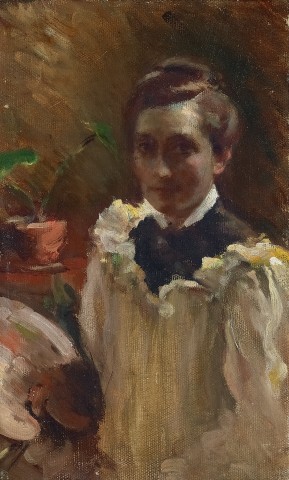SELF PORTRAIT, c.1896
JOSEPHINE MUNTZ ADAMS
oil on canvas
31.0 x 19.0 cm
Emil Aldor, Melbourne
Deutscher Fine Art, Melbourne
Private collection, Melbourne, acquired from the above February 1980
Thence by descent
Private collection, Victoria
Self Portrait with Palette, c. 1920s, oil on canvas on board, 31.0 x 24.0 cm, private collection
Josephine Muntz Adams is an artist who deserves to be better known. At the height of her career, her works commanded ‘several hundred pounds a year’ and she charged (the high price of) ‘150 pounds for a portrait.’1 In particular, Muntz Adams was acclaimed for her ‘touch of genius’ in the ability to capture the personality of her sitters through the expression in their eyes.2 She initially studied at the National Gallery Art School during the 1880s alongside Aby Altson, David Davies and Arthur Streeton, and was a peer to Clara Southern and Jane Price. At the age of twenty-eight, Muntz Adams travelled to Europe for further training and due to her youthful appearance, it is plausible that this vital self portrait was painted during this overseas sojourn, which lasted until 1896 when the artist was thirty-four.
Self Portrait shows Muntz Adams as she wanted to be seen – active, industrious, and above all, creative. A gifted pianist and the eldest of seven children, she was born in Kyneton before the family moved to Prahran, where her father was subsequently elected Mayor. Her mother was a supporter of the suffragette movement, and her younger sister became one of the earliest female science graduates of the University of Melbourne. Muntz Adams began her art training at the age of fourteen at the Prahran School of Design before enrolling at the Gallery School in 1882 under George Folingsby. Her major student painting, Care, 1887, was so acclaimed that it was purchased by the Queensland National Art Gallery, Brisbane - thereby becoming the first painting by an Australian artist to enter that collection.3 In Europe, she studied initially at the Académie Colarossi in Paris, which encouraged a greater freedom of expression than the more popular Académie Julien; and in 1892, Muntz Adams achieved the notable distinction of having a portrait ‘hung on the line’ at the Paris Salon. She then chose to study under renowned portraitist Hubert von Herkomer in the English artists’ colony of Bushey ‘where between 200 and 300 painters have settled partly out of respect for the great portrait painter and partly because Bushey has a certain fascination of colour.’4 Muntz Adams returned to Melbourne in 1896, married two years later and moved to Brisbane. However, she continued to exhibit overseas and in 1899, was awarded a gold medal for portraiture in the Greater Britain Exhibition in London.
Following her husband’s sudden death in 1903, Muntz Adams returned to Melbourne and served on the Victorian Artists’ Society council for many years. Her house in Malvern had an attic studio occupying the top floor which ‘resembled an oriental bazaar with velvet hangings, Persian carpets, couches draped with silken shawls and Muntz Adams’ paintings, which covered the walls and were stacked against them.’5 A major retrospective, held in 1943 at the Athenaeum Gallery when the artist was eighty years old, was opened by Sir Keith Murdoch. In his speech, Murdoch rightfully claimed that ‘the history of Australian art ... should be more familiar with the work of Josephine Muntz Adams. [She] has every right to a permanent position in Australian painting.’6
1. Moore, W., ‘Careers for Australian Girls’, The New Idea: a women’s home journal for Australia, Melbourne, 6 December 1907
2. ‘Art and Artists’, Table Talk, Melbourne, 2 October 1896, p. 6
3. Subsequently re-named the Queensland Art Gallery
4. ‘Art and Artists’, op. cit.,
5. Hammond, V. and Peers, J., Completing the picture: women artists and the Heidelberg era, Heide Park and Art Gallery, Melbourne, 1992, p. 58
6. Sir Keith Murdoch, 1943, see ibid.
ANDREW GAYNOR
